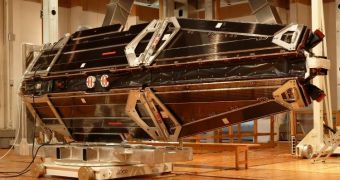Officials from the European Space Agency (ESA) announce that the first of three satellites in the Swarm constellation has just completed magnetic testing. This network of spacecraft is the first Europe is constructing specifically for Earth observations.
Primarily, the instruments aboard Swarm satellites will be used to analyze the planetary magnetic shield in more detail than ever before. Data collected in this manner could lead to a better understanding of how space weather affects Earth and its magnetosphere.
In addition, the information could also be used to gain new insight into how the planetary core functions. Earth's magnetosphere is generated by the fact that the solid iron core at the center of our planet spins inside the mantle.
The purpose of the Swarm mission is to discover more details of all these phenomena, and more. Still, before they are launched, ESA needs to ensure that the satellites are perfectly equipped to withstand the harsh conditions of space.
All three satellites will launch from the Plesetsk Cosmodrome in northern Russia in 2012. They will be carried to orbit aboard a Rokot delivery system, which is a modified UR-100N (SS-19 Stiletto) intercontinental ballistic missile (ICBM).
As the launch date draws nearer, engineers at ESA and IABG, in Ottobrunn, Germany, are working as hard as they can to analyze the spacecraft and all of their aspects. The new-generation magnetometers these satellites carry are their most important instruments.
These tools will be able to analyze Earth's magnetic field, and determine its sources with great accuracy. While the core and magnetic rocks contribute to the field to a great extent, there are other mysterious sources of magnetism on our planet as well, which have thus far remained mysterious.
“The testing program will conclude next February, after which the three satellites will be packed up and shipped to the Plesetsk Cosmodrome where they will be made ready for launch in July,” a press release from ESA reads.
“Carried out by engineers from EADS-Astrium, the testing program began over a year ago. This long series of tests simulates the harsh environment of space, exposing each satellite to different temperatures, vibration and shocks,” the statement adds.
One of the most important fine-tuning procedures that mission engineers need to complete is determine how the magnetism of the three spacecraft – and magnetometers they carry – will influence the overall measurements.

 14 DAY TRIAL //
14 DAY TRIAL //